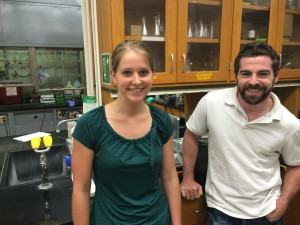Sean Culver and Carrie McCarthy are graduate students in Chemistry working with Richard Brutchey, developing and optimizing systems for energy conversion and storage. They are both recipients of the NSF GRFP award, and took some time to talk with me about their experiences.
AF: How did you find out about the fellowships you’ve applied for?
CM: Our advisor and department encourage students to apply for outside funding, especially to the big fellowships like the NSF GRFP.
SC: I also applied for the Department of Energy fellowship. I didn’t get it, but even if I had, you’re only allowed to accept one federal fellowship.
AM: Do you have any advice concerning the NSF GRFP application?
SC: It’s useful to see previous successful applications, even for things as simple as how to lay out your proposal. Even if you know what to say, an application that’s even somewhat disorganized can get passed over.
CM: I agree. You want to make it very straightforward to read. It needs to be concise and specific in a page and a half.
SC: They don’t tell you much about how to do it. You might think initially that you’re just doing regular essay writing, but in mine I used bullet points and bolded important things. You have to know that they’re reading thousands of applications, so making yours stand out and fast to read can make a big difference.
AF: What was the process itself like for you?
CM: My application was actually during the sequestration, so I didn’t even know if there was going to be an active government to review my application! I couldn’t edit my application on FastLane, so I wrote and revised all my drafts on my computer, and hoped the website would come up in time. My main problem was trying to be concise. You end up trying to squish everything into the application. You wonder if references count toward your space allotment, shrink the font, and make your images small. Things like that. That was the hardest part for me.
AF: Did you have help with that?
CM: Yeah, I showed my first drafts to my undergraduate and graduate advisors, and they helped me decide which things were the most important to leave in and which things I could take out.
SC: It was pretty time-consuming and stressful. I went through numerous drafts myself. I was a TA during my first semester, but I knew who I wanted to advise me, so I was able to hit the ground running with the application. The ideas for the proposal have to come from the student, so even though I had help from my advisor, and other people helped me revise it, I still had to put in a lot of time. I must have gone through 5 drafts per part.
CM: It was pretty stressful for me too. Plus then you wait to hear back for over 6 months, that was stressful too. I mean, you forget about it eventually. But still.
SC: I actually ended up forgetting about it to the extent that I found out I won from another awardee!
AF: How did you go about getting letters of reference?
SC: You want your letters to be good, and you need them to be from people who know you, so sometimes you need to ask people from different institutions. I contacted someone from an old job. But you also have to realize that the people you’re asking are busy people and you’re asking them to do something time-consuming, so it’s not a small request. You’ll also likely have to ask them repeatedly if they’ve done it yet, sometimes right up until the deadline.
CM: I contacted my undergraduate advisor, who had written letters for me multiple times. I also approached the authors of the letters I used for my grad school application, as well as my undergrad department chair.
AF: What do you feel you gained out of the application process itself?
SC: The NSF application is great practice for writing grant proposals. The DOE application is pretty frustrating; it’s a bunch of prompts and text boxes that you just have to cut and paste answers into.
CM: Knowing about what sections reviewers expect to see in a proposal and what information they’re interested in was useful. They might be interested in your previous research and project proposal, but “broader impact” is important too, and I wouldn’t have realized this before applying.
SC: It forces you to think about who else you can help during your Ph.D. It also inspired me to seek out opportunities to help out in the community. I sought out an opportunity and started helping students at Cerritos College.
AF: So having to think about your “Broader Impact” section oriented you to making a broader impact?
SC: Yeah! At first, you panic about how much work you have to do to get your Ph.D., but this application makes you think about how your graduate studies could help other people.
CM: People who take the time to apply for the NSF fellowship are usually the type of people who are very determined but also want to make a broader impact and are willing to make extra efforts outside of their own graduate work. You have to see into the future and make a plan about your research even to just do the application, and the process can open your mind to thinking about how to start helping others now.
SC: The moral here is that the Broader Impact section is an extremely important part of the application.
CM: As well as the most difficult. However, I actually also had fun thinking about it. They also want to know on the application what “Broader Impact”-type activities you have done in the past.
AF: How are your projects going?
CM: The project you write about in the proposal actually doesn’t last more than a year or two. You’ll probably start a number of other projects along the way. You’ll start with that proposal project. Maybe it will work and maybe it won’t, but it’s not going to carry you through graduate school. And even if it fails, the fellowship doesn’t fail, so to speak.
SC: I have made a decent amount of progress on my proposed project, but the good thing about the NSF fellowship is that it allows you the freedom and funding to work on a variety of projects at the same time.
AF: Sean, what do you think was the difference between the two fellowships you applied for that allowed you to win one but not the other?
SC: The NSF had more room for style and organization, whereas that disappears in the DOE application since it’s all cut-and-paste. And a good fraction of it is luck!
CM: How many people apply for the DOE fellowship?
SC: About the same as the NSF I’d imagine. But the NSF has about 2000 awards, and the DOE only has about 50.
AF: Any other NSF-specific advice?
SC: Suck up your pride and let as many people read your application as possible. I mean, if your writing extremely personal things, then obviously not, but if you can, let as many people see it as possible.
CM: I had my boyfriend read it. He’s in film, and he thought it was too dry, and that really helped me improve my application.
AF: But that’s probably only true for the non-technical sections, right?
CM: Not really. You need to write the technical parts for people who aren’t experts in your field, even though the reviewers are expert scientists and engineers, etc.
SC: Going through the previous research part shows the reviewers what you’re most familiar with, but you’re at risk for doing things like using over-complicated jargon and using field-specific explanations. If you break out of that a bit, you have to explain things more simply and give more general explanations, which is a really good skill for writing proposals.
AF: How has having this fellowship altered your graduate experience?
CM: Time! I may have had to TA full or part time if I didn’t have this fellowship.
SC: I got to go to a Gordon conference that I wouldn’t have been able to go to otherwise using fellowship-related funds.
AF: Is that a separate fund aside from your fellowship stipend, tuition, and fees?
SC: Yeah. NSF gives you access to research funds for things like conferences and chemicals, and each expenses has to be cleared by your professor.
CM: NSF gives that money to your institution and they decide what happens to that money. Some schools keep it, some schools add it directly to your stipend. Here at USC, they keep it in a fund that you can draw on for your professional needs.




